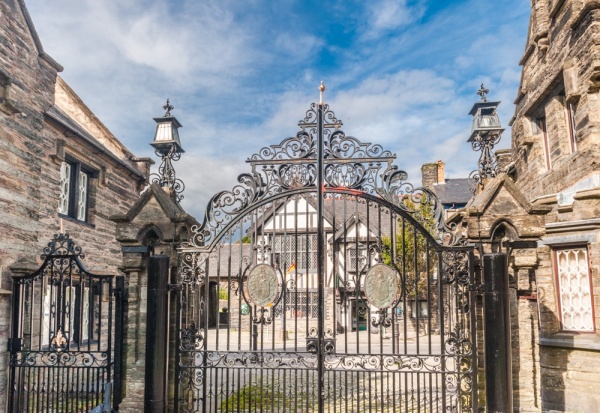
Machynlleth (often referred to simply as 'Mach') is a historic market town in the Dyfi Valley, at the western extremity of the old county of Montgomeryshire.
History
Though this area of the Dyfi Valley has been settled since the Bronze age, the story of Machynlleth really begins with the arrival of the Romans in the 1st century AD. The Romans built a fort at Pennal and a pair of lookout posts on the hills above the town site.
The town itself developed during the medieval period. The most important early date in the town's history was 1291 when Edward I granted a royal charter to Owen de la Pole, Lord of Powys, allowing him to hold a weekly market every Wednesday and two fairs a year. Over 700 years later the Wednesday market is still thriving.
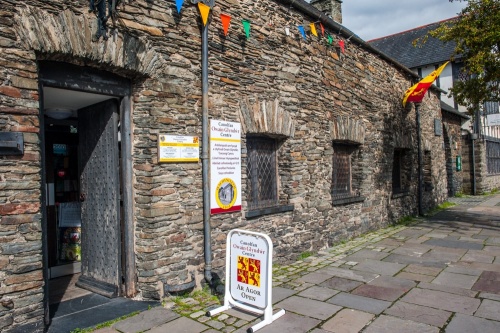
Owain Glyndwr
Machynlleth occupies a special place in Welsh history. It was here in 1404 that Owain Glyndwr, a rebel against the English crown, was proclaimed Prince of Wales in the presence of envoys from France, Scotland and Castile.
Glyndwr held a parliament, a gathering of representatives from across Wales, possibly at the building now known as the Owain Glyndwr Centre. In 1406 he issued his famous Pennal Letter from the church at Pennal, just a few miles to the west. After his rebellion faltered Glyndwr went into hiding in the Machynlleth area.
On the basis of hosting Glyndwr's parliament Machynlleth bills itself as 'the ancient capital of Wales', which is a bit of a stretch. It certainly never held any official status as a capital but it is still a place close to Welsh hearts. Each September the Glyndwr Festival celebrates Owain Glyndwr's legacy and marks the beginning of his rebellion against the English in 1400.
Civil War Battle
On 29 November 1644 a Royalist army under Rowland Pugh, Lord of Meirionedd, met a Parliamentary force under Sir Thomas Myddleton of Chirk near the Dyfi Bridge. The victorious Parliamentarians proceeded into Machynlleth to burn houses used by the Royalists.
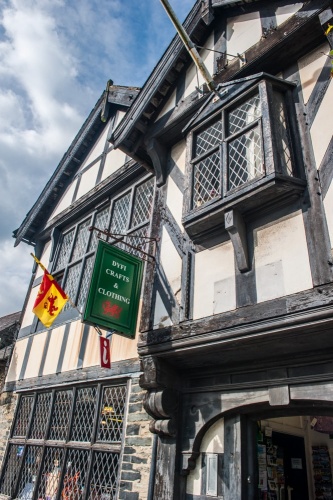
Places to See
Owain Glyndwr Centre
The most interesting historic building in Machynlleth is the Owain Glyndwr Centre on Heol Maengwyn (the A89). The alternative name of the building is Owain Glyndwr's Parliament House, for it was in a building on this site that Glyndwr called his famous Parliament in 1404.
Historians have determined that the building dates to 1460, long after Glyndwr's time, but it is thought that the structure we see today is simply a reconstruction of the earlier building on this site, so it is certainly plausible that the Centre incorporates Glyndwr's original parliament building.
The Centre is a wonderful museum and information centre, explaining Owain Glyndwr's life, his ties to Machynlleth, the 1404 Parliament, and his legacy. See a replica of the 1406 Pennal Letter sent by Glyndwr to Charles VI of France, where he refers to himself as Prince of Wales.
Plas Machynlleth (Y Plas)
In the heart of Machynlleth is Y Plas, or Plas Machynlleth, a Victorian mansion and former home of the Marquess of Londonderry. The mansion incorporates an earlier 18th-century house and a yet earlier 17th-century manor. In 1948 the 7th Marquess gave Y Plas to the town. The grounds became a public park and the house was used as a school, council offices, and finally as a community centre, art gallery, and event venue.
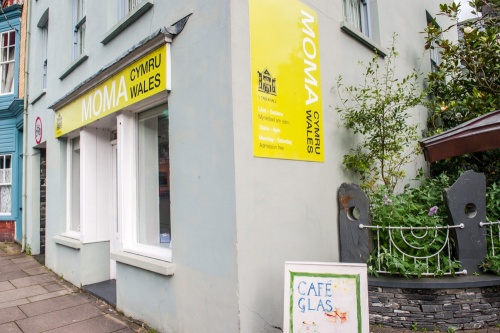
MOMA Wales
On Penrallt Street Street is the Museum of Modern Art (MOMA) Wales, a popular art centre, auditorium, and gallery partly housed in a former Wesleyan chapel. MOMA hosts a series of regularly changing exhibits by modern Welsh artists throughout the year. It also maintains a permanent exhibit of works by artists from 1900, emphasising works by artists living or working in Wales.
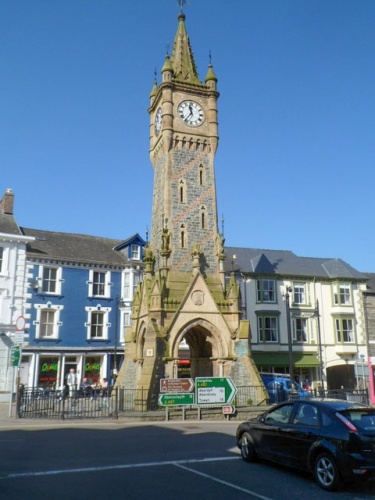
St Peter's Church
The first church here was established by St Cybi in the 6th century and rebuilt in the 13th century. The dedication was altered to St Peter in the medieval period. The church was rebuilt and restored three times in the 19th century, but many medieval details remain including the late-medieval tower.
Clock Tower
The focal point of Machynlleth, and its most famous landmark, is the Town Clock (aka The Castlereagh Memorial Clock), built in 1873 to mark the 21st birthday of Charles Stewart Vane-Tempest, Viscount Castlereagh, the eldest son and heir of the Marquess and Marchioness of Londonderry.
Manorial Court House
On the A489 stands an attractive timber-framed building known as The Court House, built in the late 16th century as a traditional hall house. The half-timbered structure was refaced in stone in 1628. Fashions change, and in the 19th century, the facade had decorative timber added to recreate the timber-framed appearance of the original medieval building. The Court House once served as the Mayor's residence. The interior features elaborate 17th-century plasterwork.
Royal House
On the corner of Poplar Road and Heol Pen'Rallt stands Royal House, a Grade II* listed timber-framed townhouse dated to 1559. Behind the main section of the house is a storage range built in 1576. The Royal House was a combination shop and dwelling, with the first documentary evidence showing it occupied in 1581.
In 1656 it was home to a draper named William Lloyd, who sold it to a mercer named Thomas Pugh. It seems to have been owned by a long succession of drapers and mercers into the 19th century. The name 'Royal House' refers to a local legend that Charles I stayed here in 1643.
Equally fascinating is the tale of Dafydd Gam, a Welsh Royalist said to have been imprisoned here from 1404-1412 after attempting to assassinate Owain Glyndwr. Since the house dates to the mid 16th century, Gam must have been held in an earlier building on the same site. After his release, Gam fought for Henry V at Agincourt where he died. He is remembered in Shakespeare's play 'Henry V'.
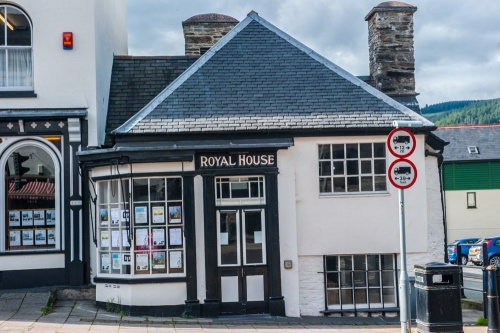
Centre for Alternative Technology
North of Machynlleth is the Centre for Alternative Technology, or CAT. The Centre showcases ways to live sustainably, with a range of interactive displays to educate young and old alike. See how renewable energy can be generated, learn about organic agriculture, composting, creating a sustainable family home and building environmentally responsible buildings. There are 7 acres of displays and the Centre hosts a regular programme of events and tours.
One fascinating exhibit is a water-balanced cliff railway, illustrating how to use the power of water to create sustainable energy that can run heavy train cars up one of the steepest cliff railways in the world.
Our family enjoyed a tour of CAT and found it inspirational and thought-provoking.
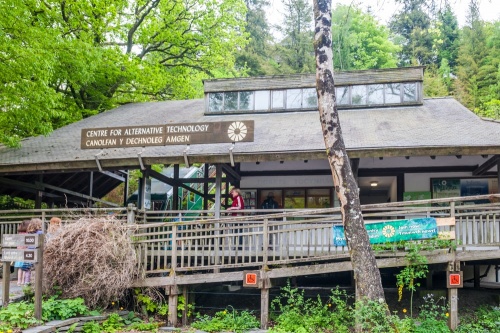
Corris Steam Railway Museum
Four miles north of Machynlleth is one of the most popular tourist attractions in Mid Wales; the Corris Railway. This delightful narrow-gauge railway opened in 1859 to carry slate the Dulas Valley to the loading wharf at Derwenlas. Carriages were hauled by horses until 1878. The railway went out of service in 1948 but has since been fully restored and makes regular steam journeys through one of the most spectacular mountain settings in Wales.
The Town Clock image is (c) Jaggery and is republished with gratitude under a Creative Commons license.
About Machynlleth
Address: Machynlleth,
Powys,
Wales
Attraction Type: Town
Location: On the A487, just off the A493 30km north-east of Aberystwyth
Location map
OS: SH745008
Photo Credit: David Ross and Britain Express
HERITAGE
 We've 'tagged' this attraction information to help you find related historic attractions and learn more about major time periods mentioned.
We've 'tagged' this attraction information to help you find related historic attractions and learn more about major time periods mentioned.
Find other attractions tagged with:
NEARBY HISTORIC ATTRACTIONS
Heritage Rated from 1- 5 (low to exceptional) on historic interest
Owain Glyndwr Centre - 0.2 miles (Museum) ![]()
Plas Machynlleth - 0.3 miles (Historic House) ![]()
Pennal, St Peter ad Vincula Church - 2.9 miles (Historic Church) ![]()
Corris Railway & Museum - 4.3 miles (Museum) ![]()
Dyfi Furnace - 5.2 miles (Historic Building) ![]()
Dolgoch Falls Waterfall Walk - 6.3 miles (Countryside) ![]()
Llanfihangel-y-pennant, St Michael's Church - 6.7 miles (Historic Church) ![]()
Castell-y-Bere - 6.8 miles (Castle) ![]()



